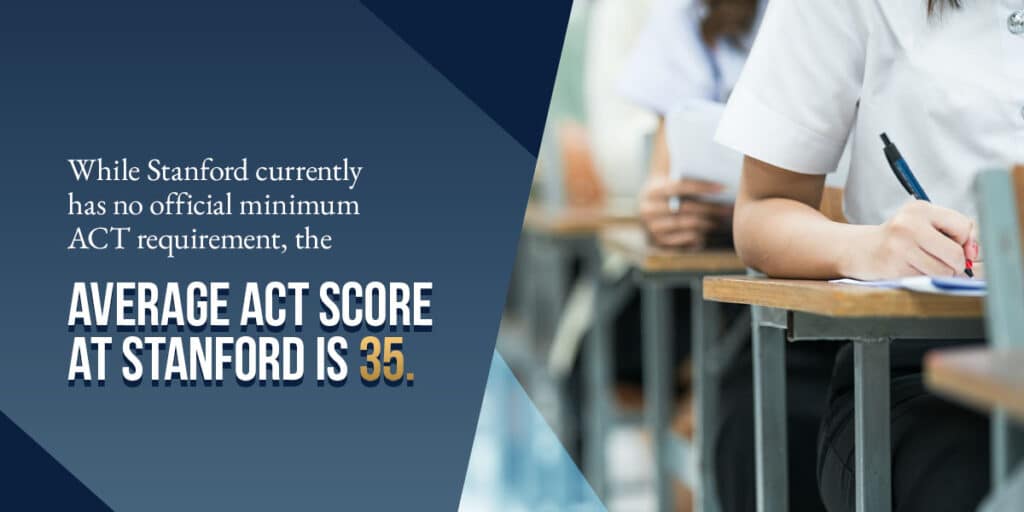Admission to a top university is a prestigious achievement that can unlock a lifetime of academic and career opportunities. That’s why one school, Stanford University, is renowned for its exceptional standards, making the prospect of getting into such a school both exhilarating and intimidating.
Students considering an application to Stanford will have the greatest chance of success when they know what to expect and how to make their application stand out. This guide will explain what it takes to get into Stanford.
How Difficult Is It to Get Into Stanford?
Stanford University has earned a reputation as one of—if not the—most selective universities in the United States. Students who make the cut have exceptionally high GPAs and SAT or ACT scores. Stanford’s admissions rate is only around 3%- 4% across tens of thousands of applicants every year.
Stanford receives between 50,000 and 60,000 applications each year, and in total, only around 1,700 freshmen and 30 transfer students receive admissions offers. Though Stanford does not report exact statistics, it is safe to assume that at least half those 50k+ applicants have unweighted GPAs above 3.8 and SAT scores over 1500. So grades and test scores are important, but grades and test scores alone are not enough to secure admission. With the right approach, you or your high school student could break through.
GPA Requirements for Stanford University
Applicants need exceptionally high grade-point averages to have a viable chance of admission to Stanford. Stanford’s 2024-2025 Common Data Set reports that the average GPA is over 3.9, and 73.3% of admitted first-year students have 4.0 GPAs, so applicants should strive for near straight As to compete among the best.
Taking challenging classes like AP or IB courses will make a high GPA look even more impressive. Most of our students tend to take 5+ AP classes, though that number varies depending on a student’s admission strategy.
Applicants at or below a 3.9 GPA can still achieve admission but should prioritize a higher SAT or ACT score and other dimensions of their application to compete with 4.0 GPA applicants.
Don’t have a 3.9+ GPA? Not taking 5+ AP classes? Students should acknowledge any academic struggles and seek immediate support if they plan to apply to Stanford. Focusing on other aspects of the college application, such as extracurriculars or research could potentially be the difference between being accepted and being rejected.
SAT and ACT Scores
Stanford has had no official requirement for SAT or ACT scores in recent years but is reinstating a standardized testing requirement for the 2025–2026 application cycle. When this requirement comes into effect, students may submit either an SAT or ACT score.
The average SAT score at Stanford is 1540/1600, and the average ACT score is 35, so taking the SAT/ACT and achieving a 1540 SAT/35 ACT or better can translate into a strong application. Students can take the SAT/ACT test times to improve their scores, and Stanford will consider the best scores to report for each section, focusing on Reading, Writing, and Math scores.

If a student takes the ACT multiple times, Stanford will accept their “superscore” by combining their best subscores from each section within the ACT. Taking the ACT several times, focusing their prep on a different section each time, and submitting the best scores for each component is an effective strategy for admissions.
Beyond GPA and Test Scores
But GPA and test scores only tell part of the story. The typical admitted Stanford student will show the ability to make significant and creative contributions outside the classroom. In comparison with other East Coast Ivies, Stanford is culturally more geared towards creating and catalyzing solutions than in abstract contemplation. This can be seen in their mission statement when they emphasize 4 key areas:
- Sustaining Life on Earth
- Accelerating Solutions for Humanity
- Catalyzing Discovery in Every Field
- Preparing Citizens and Leaders
Each of these sub areas prioritize active verbs about a thing that students are doing. If all a student is doing is studying for the SAT and getting good grades, then that student isn’t yet doing enough to show an ability to creatively lead and effectively catalyze change.
Now, the “solutions” focused nature of Stanford’s cultural legacy as an engineering institution does NOT mean that they are just looking for “practical engineering types.” Stanford expects sensitivity and reflection and collaboration among the leaders and solution-makers that it invites into its campus. They don’t just want to know that you’ve engineered the “most efficient solution”; they want to know how you’ve critically defined efficiency and how you have been thoughtful about the specifications that you’ve offered. For example, if you started to design a headset to aid the visually impaired, have you partnered with multiple different people in the visually impaired community to gather feedback and fine-tune the features that you decided to include?
Design thinking, as a principle, is something that has percolated throughout Stanford as an institution. This means that even if a student is applying as a humanities and social sciences major, they should be implementing some of the ideas and weaving them–artfully–into application essays. As the Stanford Design School (or d.school) states:
- “The nature of design affords people the opportunity and privilege to shape the world that they-and others-inhabit. This is power. In a just world, that power is shared, prioritizing the voices and ideas of people most impacted by the intended and unintended effects of new designs. We aim to actively confront and challenge the mindset that design can only be used by a privileged few.”
What this means, in practical terms, for a student’s extracurriculars and application is that no matter how a student is deploying their innovation and creativity, they should be able to think critically about the impact that those innovations will have.
Other Requirements for Stanford University
Besides GPAs and SAT or ACT scores, factors that can influence a Stanford application’s outcome include:
- Personal statement: The Stanford application form includes submitting the Common Application’s Personal Statement, a 650-word essay that is required for most schools and will be the same for each. The goal of the essay is to bring a fundamentally human element to one’s application. The Personal Statement should speak to one’s quantitative and qualitative strengths, show a sense of critical thinking, celebrate accomplishments, and communicate personality. This is the one place on the Common Application where students get to show who they are (and who they hope to become) in their own words, with their own voice.
- Supplemental Essays: Students will be required to answer a variety of short questions (limit 50 words each) and short essays of 250 words maximum. Applicants should aim to convey their background, merit, and motivations in a compelling narrative. It’s worth writing and reviewing several drafts to refine this component.
- Letters of recommendation: Stanford requires letters of recommendation from two teachers and a guidance counselor. Teachers and counselors receive a link to submit their letters to Stanford, so students may not get to read the letters themselves. Applicants should choose teachers from two different subject areas who know them well and can share complementary perspectives on their strengths.
- Extracurriculars: While Stanford prioritizes academic excellence, it also considers activities outside the classroom. Strong applicants have a deep commitment to a couple of sporting, cultural, or community activities that they balance well with academic pursuits. Stanford values depth of commitment and height of achievement in extracurriculars over sheer breadth of interests.
- Location: Stanford enrolls students from all 50 states and many countries around the world. Applicants from underrepresented states are attractive as Stanford embraces geographic diversity.
- Interviews: Stanford offers conversational interviews to some applicants. Acceptance is possible without an interview, but applicants who receive interview opportunities should aim to set themselves apart by making a strong, positive impression.
Stanford Admissions Processes
Stanford offers a few different application deadlines:
- Restrictive Early Action: This option comes with an earlier application deadline — November 1 instead of the regular decision deadline of January 5. For students with strong SAT or ACT scores who know Stanford is their top choice, taking this option could be wise. Note that applying Restrictive Early Action will keep the student from being able to apply for the binding Early Decision options that many other schools (like Johns Hopkins or the University of Chicago) offer. Binding Early Decision options will also usually offer a larger benefit for a student’s admissions chances than Stanford’s Restrictive Early Action option will, so this option should only be chosen if Stanford truly is the student’s first choice school and if the student’s application is exceptionally strong.
- Regular Decision: This is the traditional process that most applicants follow, and is usually due around January 5th.
- Arts Portfolio Deadlines: There is also one final nuance: if an applicant has an arts portfolio (maybe they are a leading young trombonist or have an impressive catalogue of work as an aspiring furniture designer), they will need to submit their application by October 15th for Restrictive Early Action and December 5th for Regular decision.
Consult Zenith Prep Academy to Enhance Your Stanford Application
When applying to a school as competitive as Stanford, every advantage is worth taking. That’s why students who are serious about getting a top-tier education should partner with Zenith Prep Academy.
We are an award-winning college counseling program with a track record of getting students into top schools. As the number-one College Consulting & Education Company in America, applicants partnering with Zenith Prep Academy have seen 500% higher acceptance rates for Ivy League and Top 15 Universities, including Stanford.
We partner with 6th-12th-grade students and their families, meeting them where they are and guiding them to acceptance at either a top university. We know the surprising factors beyond GPAs and test scores that make or break an application, and we back our commitment with a 100% money-back guarantee.
Thousands of parents across the U.S. assure that we keep our word by helping students attend their dream universities. Book a free consultation to learn how we can strengthen your Stanford application.







